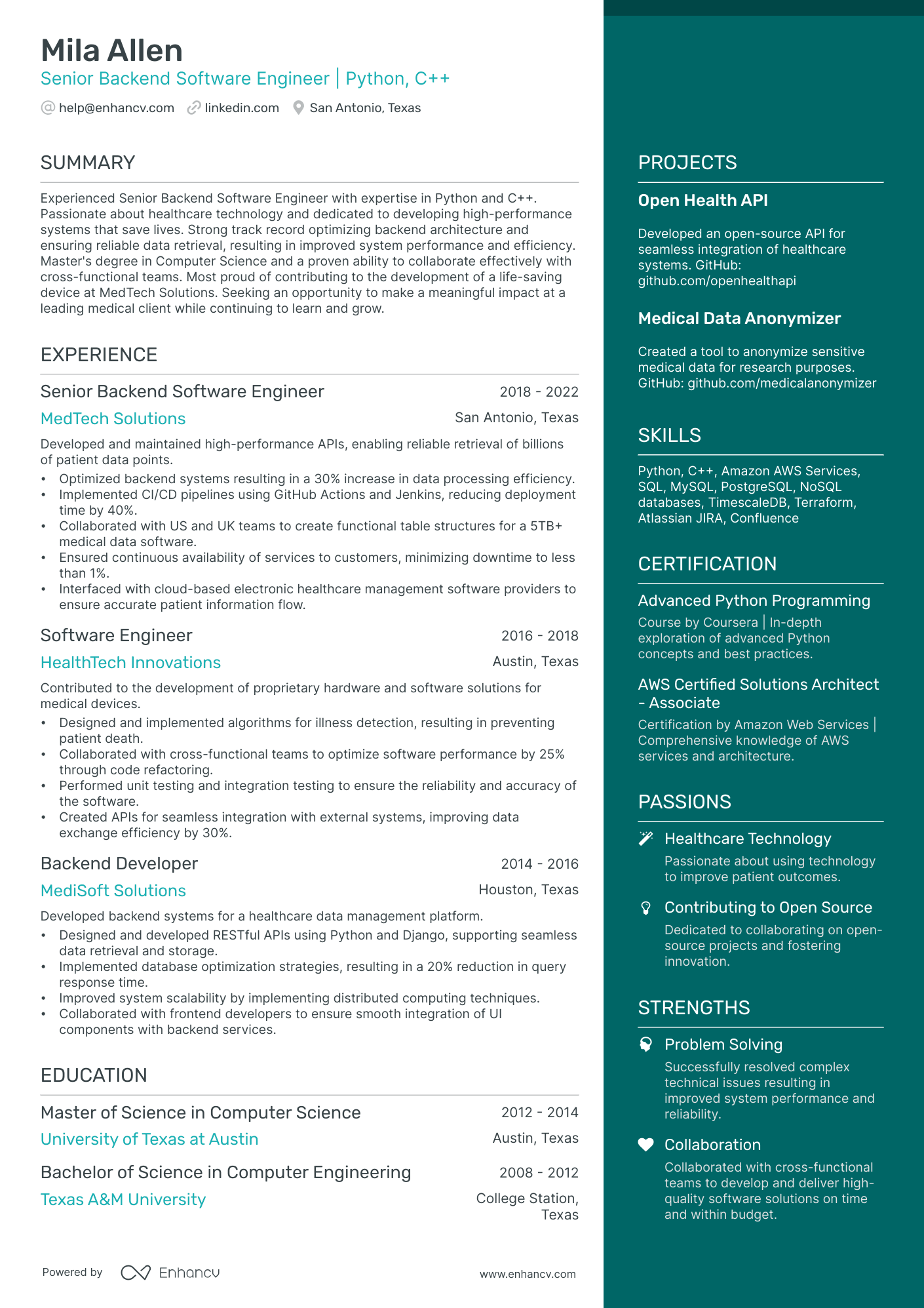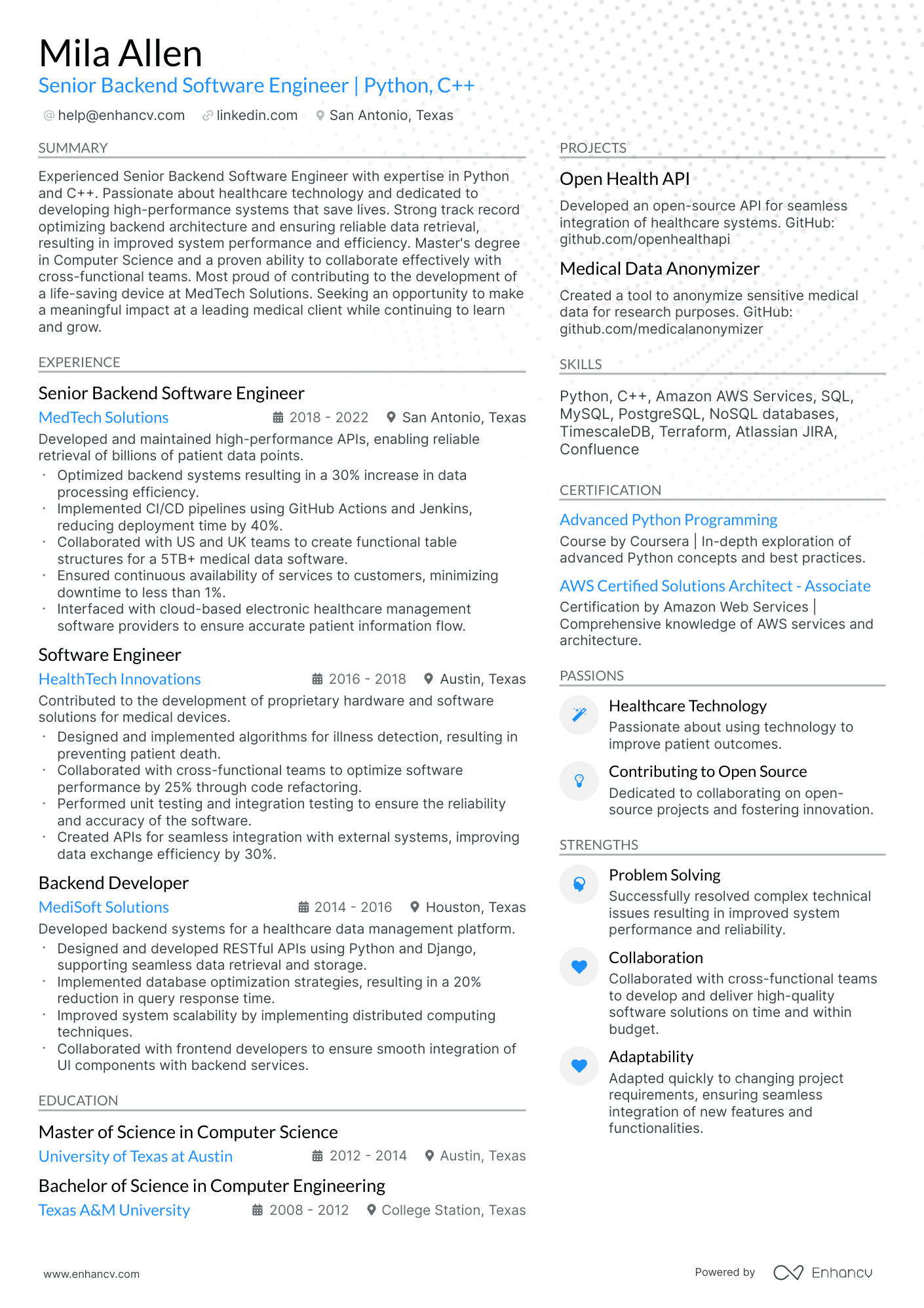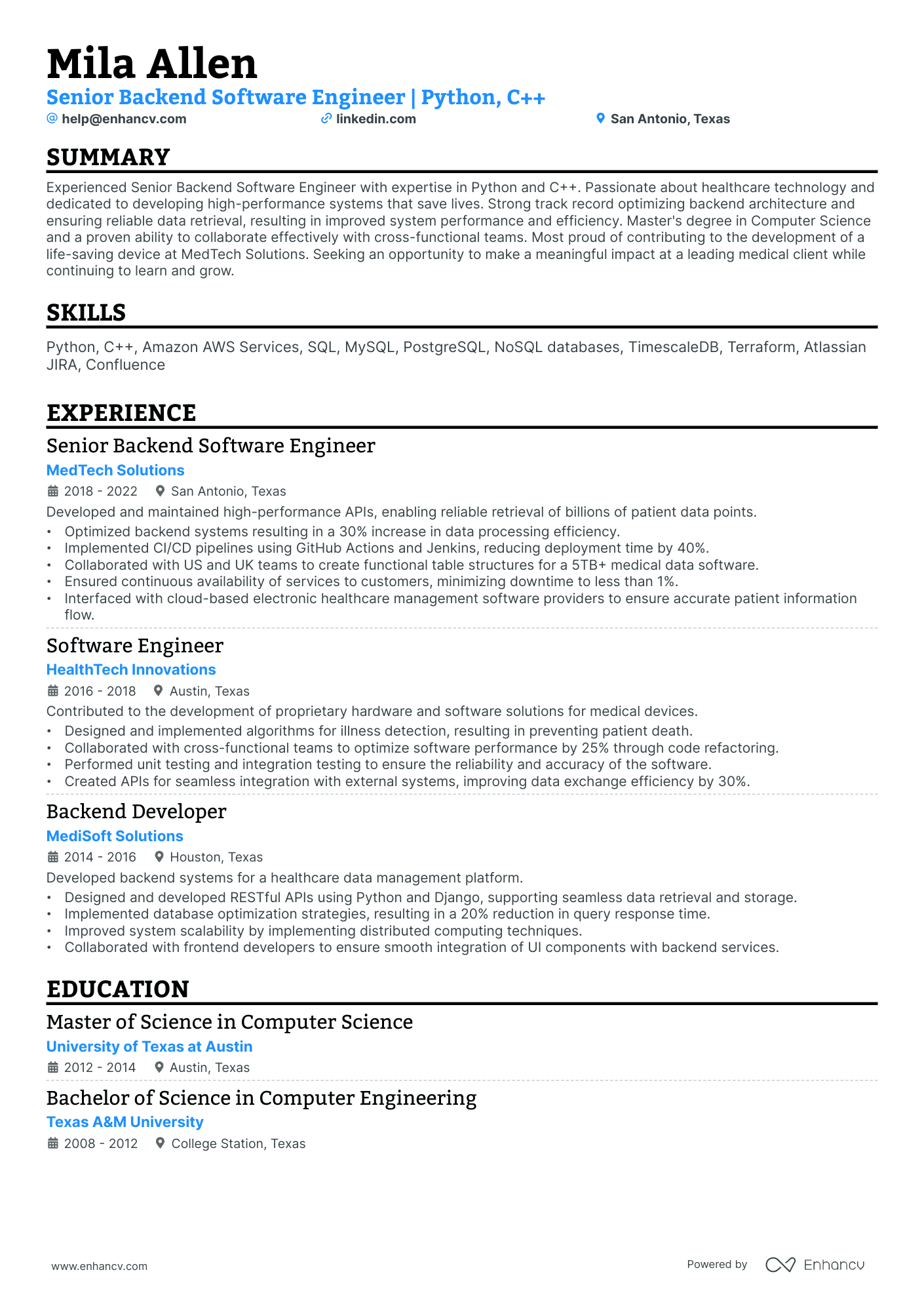One significant resume challenge faced by an AWS solutions architect is effectively demonstrating a broad range of skills, such as knowledge of various AWS services, problem-solving abilities, and experience with cloud technologies. Our guide can assist in addressing this challenge by providing targeted examples and templates that highlight how to best showcase these skills and experiences, making your resume stand out to potential employers.
Our AWS solutions architect guide will help you perfect your resume by explaining you how to:
- Alight your AWS solutions architect resume with the role you're applying for ensuring it will be read by the applicant tracking system.
- Tailor your specific AWS solutions architect experience to get the attention of recruiters.
- List your relevant education to impress hiring managers.
- Discover job-winning AWS solutions architect professional resume examples to inspire writing yours.
Recommended reads:
Tips for refining your AWS solutions architect resume format
The resume format sets the stage for your professional narrative. Ensure it:
- Adopts the reverse-chronological format, placing your most recent experiences at the forefront. This format is ideal for those with relevant and up-to-date experience.
- Features a clear headline, making it straightforward for recruiters to access your contact details, portfolio, or current role.
- Stays concise, ideally spanning no more than two pages, focusing on relevant experiences and skills.
- Maintains its layout by being saved as a PDF, ensuring compatibility with Applicant Tracking Systems (ATS).
Consider the local standards – Canadian resumes, for example, may have a different format.
Upload your resume
Drop your resume here or choose a file. PDF & DOCX only. Max 2MB file size.
Pro tip
Choose a functional resume template that offers ample space to showcase your unique AWS solutions architect expertise.
To craft a compelling AWS solutions architect resume, focus on these sections:
- A scannable header
- A snapshot of your professional persona, showcasing soft skills, achievements, and a summary or objective
- Skills that align with the job advert
- Quantifiable achievements in your experience section
- An education and technical skills section that underscores your proficiency with specific tools or software
What recruiters want to see on your resume:
- Deep understanding of Amazon Web Services (AWS) and its core products, including EC2, S3, RDS, VPC, IAM, CloudFormation, etc.
- Experience in architecting, designing, and deploying scalable, highly available systems on AWS.
- Proficiency in one or more scripting languages (Python, Bash, etc.) for automation of AWS infrastructure.
- Demonstrated ability to implement cost control strategies and understanding of AWS pricing model.
- Certifications such as AWS Certified Solutions Architect - Associate or Professional level.
Recommended reads:
guide to your most impressive AWS solutions architect resume experience section
When it comes to your resume experience, stick to these simple, yet effective five steps:
- Show how your experience is relevant by including your responsibility, skill used, and outcome/-s;
- Use individual bullets to answer how your experience aligns with the job requirements;
- Think of a way to demonstrate the tangible results of your success with stats, numbers, and/or percentages ;
- Always tailor the experience section to the AWS solutions architect role you're applying for - this may sometimes include taking out irrelevant experience items;
- Highlight your best (and most relevant) achievements towards the top of each experience bullet.
You're not alone if you're struggling with curating your experience section. That's why we've prepared some professional, real-life AWS solutions architect resume samples to show how to best write your experience section (and more).
- Designed and implemented scalable AWS architectures for enterprise clients, resulting in a 30% reduction in infrastructure costs.
- Led a team of engineers in the migration of a legacy application to AWS, improving system performance by 50%.
- Developed disaster recovery strategies using AWS services, ensuring business continuity during critical events.
- Collaborated with cross-functional teams to design and deploy highly available and fault-tolerant AWS solutions.
- Performed cost optimization analysis on existing AWS infrastructure, resulting in annual savings of $100,000.
- Implemented automated CI/CD pipelines using AWS CodePipeline, reducing deployment time by 40%.
- Assessed customer requirements and provided technical guidance for the integration of AWS services into their IT infrastructure.
- Developed and delivered training programs on AWS best practices, enabling internal teams to leverage cloud technologies effectively.
- Led the implementation of a cloud-based data analytics platform, enabling real-time data processing and analysis for clients.
- Collaborated with development teams to architect and deploy highly scalable cloud-native applications on AWS.
- Optimized application performance by implementing AWS auto-scaling groups and load balancers, resulting in a 50% reduction in response time.
- Designed and implemented security measures, including AWS IAM roles and VPC configurations, ensuring data privacy and compliance.
- Assisted customers in designing serverless architectures using AWS Lambda and API Gateway.
- Implemented multi-region AWS deployments for high availability and disaster recovery purposes.
- Developed infrastructure as code using AWS CloudFormation, enabling consistent and reproducible environment provisioning.
- Led the migration of legacy systems to AWS, resulting in improved scalability and reduced maintenance costs.
- Implemented AWS Identity and Access Management (IAM) policies to enforce granular access controls and enhance security.
- Collaborated with DevOps teams to automate infrastructure deployment using tools like AWS CloudFormation and Ansible.
- Architecting and deploying highly available and fault-tolerant AWS solutions for enterprise clients.
- Providing technical guidance and best practices to ensure optimal utilization of AWS services.
- Designing and implementing cost-effective cloud architectures to maximize return on investment for clients.
- Collaborated with development teams to design and implement scalable microservices architecture on AWS using services like ECS and Lambda.
- Designed and implemented data lake solutions on AWS, enabling efficient data storage, retrieval, and analytics.
- Implemented AWS security best practices, including VPC peering, NACLs, and Security Groups, ensuring a secure environment.
- Assessed client infrastructure and designed hybrid cloud solutions integrating AWS services with on-premises systems.
- Implemented disaster recovery strategies using AWS backup and replication technologies, minimizing downtime during critical events.
- Created and delivered technical presentations and workshops on AWS services and their benefits to customers.
- Led the migration of legacy applications to serverless architectures on AWS, leveraging services like AWS Lambda and API Gateway.
- Developed and implemented highly scalable and fault-tolerant AWS solutions for e-commerce platforms, handling millions of transactions per day.
- Performed security assessments and implemented AWS security controls, ensuring compliance with industry standards and regulations.
Quantifying impact on your resume
<ul>
Navigating the resume landscape without experience
It's not uncommon for candidates lacking direct experience to secure entry-level positions. Their resumes often share these characteristics:
- They opt for a functional or skill-based format, emphasizing strengths over chronological work history.
- Transferrable skills, gleaned from diverse life and work experiences, take center stage.
- The objective section melds career highlights, the motivation behind the application, and the unique value proposition for the role.
- Skills are tailored to meet basic job prerequisites while also spotlighting any specialized expertise.
Recommended reads:
Pro tip
Ensure your AWS solutions architect experience descriptions resonate with both tech-savvy and non-tech audiences. Adopting a consistent format, such as task-action-result, can lend clarity and coherence to your experience section.
creating your AWS solutions architect resume skills section: balancing hard skills and soft skills
Recruiters hiring for AWS solutions architect roles are always keen on hiring candidates with relevant technical and people talents.
Hard skills or technical ones are quite beneficial for the industry - as they refer to your competency with particular software and technologies.
Meanwhile, your soft (or people) skills are quite crucial to yours and the company's professional growth as they detail how you'd cooperate and interact in your potential environment.
Here's how to describe your hard and soft skill set in your AWS solutions architect resume:
- Consider what the key job requirements are and list those towards the top of your skills section.
- Think of individual, specific skills that help you stand out amongst competitors, and detail how they've helped you succeed in the past.
- Look to the future of the industry and list all software/ technologies which are forward-facing.
- Create a separate, technical skills section to supplement your experience and further align with the AWS solutions architect job advert.
Find the perfect balance between your resume hard and soft skills with our two lists.
Top skills for your AWS solutions architect resume:
AWS EC2
AWS S3
AWS Lambda
AWS RDS
AWS CloudFormation
AWS VPC
AWS IAM
AWS CloudWatch
AWS API Gateway
Docker
Problem Solving
Communication
Teamwork
Time Management
Adaptability
Critical Thinking
Attention to Detail
Leadership
Creativity
Customer Focus
Pro tip
Sometimes, basic skills mentioned in the job ad can be important. Include them in your resume, but don't give them too much space.
The importance of your certifications and education on your AWS solutions architect resume
Pay attention to the resume education section . It can offer clues about your skills and experiences that align with the job.
- List only tertiary education details, including the institution and dates.
- Mention your expected graduation date if you're currently studying.
- Exclude degrees unrelated to the job or field.
- Describe your education if it allows you to highlight your achievements further.
Your professional qualifications: certificates and education play a crucial role in your AWS solutions architect application.
They showcase your dedication to gaining the best expertise and know-how in the field.
Include any diplomas and certificates that are:
- Listed within the job requirements or could make your application stand out
- Niche to your industry and require plenty of effort to obtain
- Helping you prepare for professional growth with forward-facing know-how
- Relevant to the AWS solutions architect job - make sure to include the name of the certificate, institution you've obtained it at, and dates
Both your certificates and education section need to add further value to your application.
That's why we've dedicated this next list just for you - check out some of the most popular AWS solutions architect certificates to include on your resume:
Best certifications to list on your resume
- AWS Certified Solutions Architect – Associate (SAA-C02) - Amazon Web Services
- AWS Certified Solutions Architect – Professional (SAP-C01) - Amazon Web Services
- AWS Certified Developer – Associate (DVA-C01) - Amazon Web Services
- AWS Certified DevOps Engineer – Professional (DOP-C01) - Amazon Web Services
- AWS Certified Cloud Practitioner (CLF-C01) - Amazon Web Services
- AWS Certified Advanced Networking - Specialty (ANS-C00) - Amazon Web Services
- AWS Certified Security - Specialty (SCS-C01) - Amazon Web Services
- Certified Cloud Security Professional (CCSP) - (ISC)²
Pro tip
If you're in the process of obtaining a certification listed in the job requirements but haven't completed it yet, be transparent. Mention your ongoing training and the expected completion date. Honesty is always the best policy on a resume.
Recommended reads:
Summary or objective: maximizing the impact of the top third of your resume
The top third of your AWS solutions architect resume is crucial. It's often the first thing recruiters see and can set the tone for the rest of your application.
Whether you choose a resume summary or a resume objective, make it count. The former is great for showcasing career highlights, while the latter balances your achievements with your future aspirations.
Both should be tailored to the role, as there's no universal approach to crafting the perfect AWS solutions architect summary or objective. Use the examples below as a starting point.
Resume summary and objective examples for a AWS solutions architect resume
Optimize your resume summary and objective for ATS
Drop your resume here or choose a file.
PDF & DOCX only. Max 2MB file size.
Extra sections to boost your AWS solutions architect resume
Recruiters love candidates who offer more. Share your personality or extra industry credentials. Consider adding:
- Projects showcasing standout work.
- Top awards or recognitions.
- Relevant publications.
- Hobbies and interests that reveal more about you.
Key takeaways
- Your resume's layout should be both visually appealing and content-rich.
- Emphasize achievements that resonate with the job's requirements.
- Detail your skills, both technical and interpersonal, with real-world examples.
- Ensure the top section of your resume provides a clear snapshot of who you are and what you offer.
- When detailing experience, focus on tasks, actions, and their outcomes.










